Author: MONK
Compiled by: Tim, PANews
Over the past year, a large number of crypto natives have emerged on Crypto Twitter, constantly lamenting the state of the industry and belittling the innovative value of our field and asset class. These criticisms do point out an objective fact and often highlight the real dilemmas in the crypto space. However, I feel that this pessimism is somewhat overblown and has completely slid into doomsday rhetoric.
In my view, while crypto pessimism may come from good intentions, it is a dangerous and misguided mindset that has become prevalent today. This article will refute this pessimistic narrative by examining the current stage of development; the reality is not as bleak as some portray it to be.
First, let’s establish some common ground:
- Most tokens and token economics currently have design flaws.
- The number of low-quality project builders is increasing, diluting the value of true builders.
- Fraud and money-making schemes are rampant.
- Truly valuable protocols account for only a tiny fraction of the entire crypto space.
- Tokens with investment value are rare.
- Protocol governance is often inefficient.
- The industry still has many legacy issues that need to be addressed.
The root causes of these problems mainly lie in the following aspects:
- We are in a stage where the regulatory framework is still unclear.
- Crypto technology has significantly lowered the barriers to asset creation and acquisition.
- However, throughout the development of the industry, there has always been a phenomenon that allows misconduct to profit.
Fortunately, these issues can be resolved, or rather, they are an inevitable product of an open but immature industry. Deep down, I think we all understand this.
I believe the real reason for the recent surge and explosion of pessimism in the crypto market is that it has become increasingly difficult for market participants to achieve excess returns. This has led to a sense of frustration and impatience akin to "bleeding out with a dull knife."
This pessimism is not related to a lack of innovation but is entirely generated by the poor structure of crypto assets.
Let’s take a look back at our achievements:
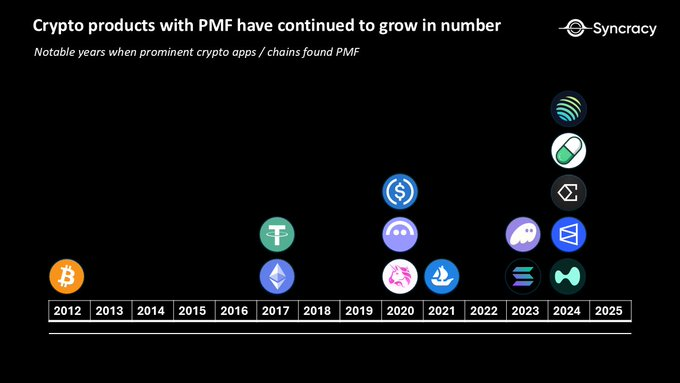
I believe these crypto products have found their product-market fit, or at least paved the way for crypto verticals that have achieved PMF. Although such products are few, as each construction cycle progresses, we are creating more products with real value through continuous improvement of infrastructure and accumulation of knowledge.
Some of you may understand after seeing this chart that good things take time, and the actual development trajectory may not be as bad as initially imagined. Conversely, some may dismissively say, "This is nothing impressive."
To the latter, allow me to show you:

You probably don’t recognize them. These are the old homepages of early internet companies. Of course, they are completely different from the internet we know and love today.
Here are some examples of failed public companies since the internet bubble burst (source: Wikipedia):
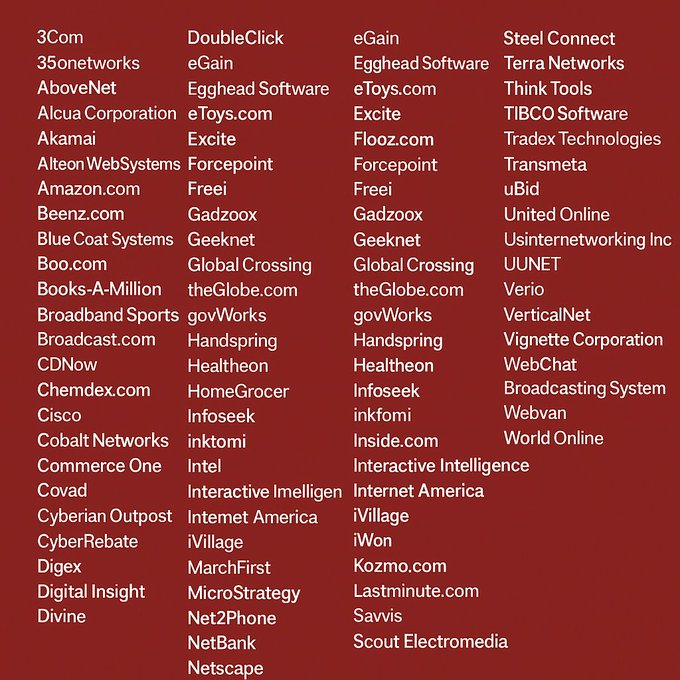
Amazon's stock price plummeted from a high of $107 to a low of $7 within two years, a drop of over 90%, and it wasn't until 2010 that it began to recover.
The actual number of "failures" in the venture capital space is several orders of magnitude higher. Thousands of companies that failed to achieve an IPO likely left most of the returns for venture capitalists in vain.
However, it is worth noting that we ultimately gained these benchmark companies:
- Amazon - Founded on July 5, 1994
- Netflix - Founded on August 29, 1997
- PayPal - Founded in December 1998
- Google - Founded on September 4, 1998
- Facebook - Founded on February 4, 2004
Similarly, artificial intelligence, as a category of innovative technology and growth narrative, is rightly receiving attention, but if we see the same power law survival rules in ten years, I wouldn’t be surprised.
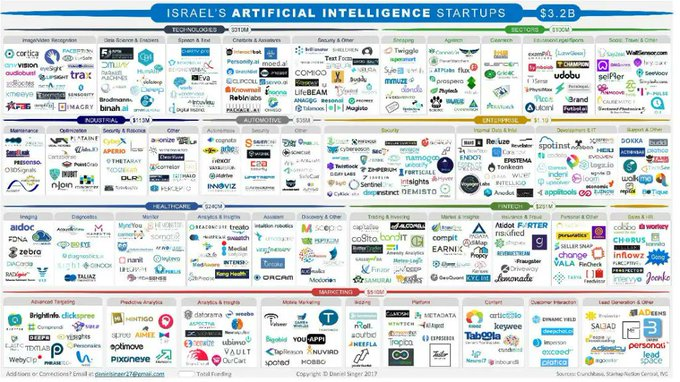
These are the leading AI startups that emerged from Israel in 2020.
If 99.9% of speculators in leading tech categories fail, why is this phenomenon so painful in the crypto space?
This is because we have turned almost all projects into venture capital, assigning public trading codes to each project. We allow any developer to launch viable, investable "startup projects" without due diligence, leading to a dramatic increase in the number of investable "companies." This has caused many retail investors to personally experience the feeling of investing in a low-hit-rate asset class, further exacerbating the growing negative sentiment towards cryptocurrencies.
Imagine if every internet entrepreneur could raise funds directly from a group of enthusiastic retail investors based solely on a half-finished project, skipping the seed round, private placement, and IPO process. Now imagine adding a platform like Pump.fun, where even the product is unnecessary.
Of course, our asset class would be filled with minefields, with stocks ready to plummet by 90% at any moment.
What Achievements Have We Made?
Today, Bitcoin has become a $2 trillion asset, and it has only been 16 years since it was launched as a cryptopunk dream by an unidentified founder.
In the decade since we first had programmable smart contract platforms:
We have built a peer-to-peer internet capable of withstanding shocks equivalent to a third world war, safeguarding trillions of dollars in value.
We have created an upgraded network that far surpasses previous performance, allowing assets to be created permissionlessly with a single click, supporting billions of dollars in decentralized spot trading volume daily.
We have enabled the entire world to hold tokenized dollars and transfer any amount to anyone almost instantly and at near-zero cost.
We have brought fundamental financial functions like lending and passive income into the on-chain world.
We have established a transparent, borderless derivatives trading platform that requires no identity verification, with trading volumes comparable to Robinhood, returning almost all revenue to token holders.
We are reshaping market structures, creating new models for buying and selling assets, while also pioneering new asset classes like prediction markets and perpetual contracts.
We have made six-figure JPEG digital collectibles a reality.
We have nurtured absurd yet vibrant online communities, where meme tokens are valued higher than public companies.
We have pioneered new capital formation models like ICOs and bonding curves.
We are exploring innovative paths to achieve financial and monetary privacy.
As I often say, we have provided every internet user with an emerging choice to replace the financial system they are forced to accept due to their nationality. Our choice, though young, is freer, more open, and more fun.
We provide the market with opportunities to invest in epoch-making technologies every year, yet valuations are as low as cabbage prices. Investors only need to sift through the information to find the truth.
Our Syncracy team believes that the "FAANG" of the crypto space is beginning to take shape, and new viable competitors will emerge every couple of years.
I often use this quote to help us reflect on this industry: "Our intuition about the future is linear. But the reality of information technology is exponential, which creates a world of difference. If I walk thirty steps linearly, I can only reach thirty. If I walk thirty steps exponentially, I can reach a billion." — Ray Kurzweil, "The Singularity Is Near: When Humans Transcend Biology"
We expect cryptocurrencies to achieve linear progressive development every year and invest in a bunch of worthless boastful projects, hoping to achieve better results this year than in previous years.
And this will ultimately lead to disappointment and losses for many. Even so, it is unreasonable to continuously voice doomsday rhetoric and criticize project development when every so-called "real" tech project has gone through the same growing pains. It’s just that in the crypto space, these growing pains are more intense because we all have a vested interest.
Looking ahead to the next decade, none of us can accurately predict the trajectory of development, nor do I believe that innovation will progress along the timelines we envision. Some years may be unremarkable, while others may see explosive growth. It is entirely possible that three years from now, there will be twenty protocols that achieve product-market fit, not just seven.
To understand the ending of the stories of the early internet pioneers, please look at the following image, and it took us a full 15 years to achieve complete recovery.
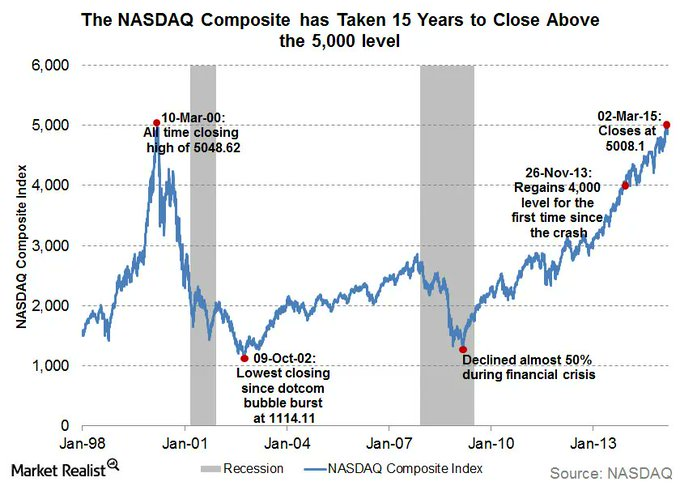
However, it is well known that the situation since then has been:
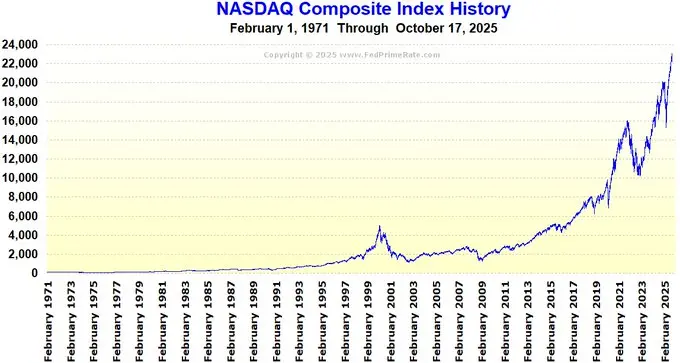
Yet just as the old guard, Wall Street elites, and high-ranking officials in the U.S. government finally began to pay attention to and recognize cryptocurrencies as a formal industry, many of us early participants seem to have wavered in our belief in this mission. I firmly oppose this.
Bitcoin remains digital gold, and we are still building new financial cornerstones to make the world a better and more interesting place.
For some of us, it is still possible to achieve excess returns through various investment avenues.
Choose crypto optimism.
免责声明:本文章仅代表作者个人观点,不代表本平台的立场和观点。本文章仅供信息分享,不构成对任何人的任何投资建议。用户与作者之间的任何争议,与本平台无关。如网页中刊载的文章或图片涉及侵权,请提供相关的权利证明和身份证明发送邮件到support@aicoin.com,本平台相关工作人员将会进行核查。




